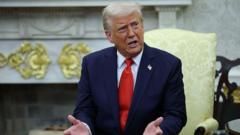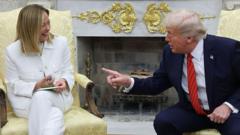As fears of an economic downturn loom, growing similarities between historical instances of market instability are igniting debates around presidential policies and their effects.
U.S. Bond Market Faces Turmoil Amid Rising Tariffs: Echoes of Liz Truss' Crisis

U.S. Bond Market Faces Turmoil Amid Rising Tariffs: Echoes of Liz Truss' Crisis
Economic analysts express concern as U.S. Treasury yields rise following the implementation of President Trump's new tariffs, drawing parallels to the market fallout triggered by former UK Prime Minister Liz Truss.
April 9, 2025, 6:15 a.m. ET marks a significant moment in financial markets as U.S. Treasury yields experienced an uptick, reminiscent of the chaos instigated by former British Prime Minister Liz Truss in 2022. Investors pulled back on government bonds, often viewed as safe havens, reflecting a broader unease surrounding the latest imposition of tariffs by President Donald Trump.
The striking comparison between Trump's current tariff escalation — including steep levies exceeding 100 percent on Chinese goods — and Truss's ill-fated tax cuts in Britain offers a sobering look at market vulnerabilities. Initially, following Trump's tariff announcement, U.S. bond yields exhibited some resilience, declining even as financial markets faltered. Yet, this stability appears to be fading, casting doubts over the enduring sanctity of U.S. Treasuries.
On Wednesday, yields for the 10-year Treasury climbed to around 4.5 percent, up from roughly 3.9 percent, while 30-year bond rates crossed 5 percent. Although current yields remain comparatively lower than those present during Trump's inauguration, a sustained sell-off could obliterate the relative calm previously observed in U.S. markets.
Concerns mount among analysts that a spiraling bond market may compel the Federal Reserve to consider intervention, mirroring actions taken by the Bank of England during Truss's tenure to stabilize the British bond market. Despite the fallout Truss faced, including her termination after a mere 44-day reign, Trump's administration continues to press forward with these tariffs, raising questions on whether significant political pressure could persuade a shift in policy.
As the world watches closely, the unfolding situation invites reflection on the interplay between market stability and government decisions, reminding us of the delicate balance that financial systems maintain in response to political maneuvers.
The striking comparison between Trump's current tariff escalation — including steep levies exceeding 100 percent on Chinese goods — and Truss's ill-fated tax cuts in Britain offers a sobering look at market vulnerabilities. Initially, following Trump's tariff announcement, U.S. bond yields exhibited some resilience, declining even as financial markets faltered. Yet, this stability appears to be fading, casting doubts over the enduring sanctity of U.S. Treasuries.
On Wednesday, yields for the 10-year Treasury climbed to around 4.5 percent, up from roughly 3.9 percent, while 30-year bond rates crossed 5 percent. Although current yields remain comparatively lower than those present during Trump's inauguration, a sustained sell-off could obliterate the relative calm previously observed in U.S. markets.
Concerns mount among analysts that a spiraling bond market may compel the Federal Reserve to consider intervention, mirroring actions taken by the Bank of England during Truss's tenure to stabilize the British bond market. Despite the fallout Truss faced, including her termination after a mere 44-day reign, Trump's administration continues to press forward with these tariffs, raising questions on whether significant political pressure could persuade a shift in policy.
As the world watches closely, the unfolding situation invites reflection on the interplay between market stability and government decisions, reminding us of the delicate balance that financial systems maintain in response to political maneuvers.





















